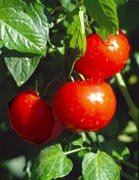Troubleshooting Tomato Problems |
|

Fresh, vine-ripened tomatoes are one of the great joys of summer. However, sometimes diseases, pests or environmental stress get in the way of our tomato harvests.
The best way to avoid tomato troubles is to start with healthy plants. Healthy plants are more able to fight off disease or pests than stressed or weak plants. Make sure that you provide adequate nutrients, water, space and sunlight for your plants. How you do that depends on your local climate. In some northern areas, you may need to stake the tomatoes in order to maximize sunlight; however in southern areas you may need to shade the plants during the hottest part of the day so they aren't scorched by the sun.
Listed below are some of the most common tomato problems and recommended solutions. Keep in mind, however, that there are dozens of other diseases and pests that tomatoes can have. The problems you face will depend on where you live and your local soils, climate and disease or pest outbreaks. Consult your local university extension office or your Master Gardener program for more information.
Fruit with black sunken areas on the blossom end are a sign of blossom-end rot. Blossom-end rot is caused by a calcium deficiency, but this can be aggravated by drought or uneven watering, root damage and excess nitrogen. You can add high-calcium lime, but do a soil test first -- just to confirm the deficiency. Consistent watering will also help.
You can also combat the problem with a ready-to-use spray called Rot-Stop, which is an all-natural formula for blossom-end rot.
Blossom-end rot will usually occur on just a small number of fruit, especially at the beginning of the harvest. Once moisture conditions stabilize, the rest of the fruit will be fine.
If few flowers form on your tomato plants or the flowers drop before setting fruit, possible causes include:
- Excess nitrogen
- Too little sun
- Nighttime temperatures above 70 degrees F or below 50 degrees F
- Drought stress
Avoid soil amendments with soluble nitrogen, be sure plants get a full day of sunlight and keep the soil evenly moist throughout the season. At planting time, use a balanced, granular fertilizer that's made for tomatoes, such as our Organic Tomato Fertilizer. During the growing season, treat your plants to a water-soluble fertilizer, such as Plant Health Care for Vegetables.
Dark, concentrically ringed spots that cover the lower leaves and stems are a sign of early blight. To control the spread of blight, apply Organic Garden Dust. Also, limit the spread of the disease by not getting water on the leaves when watering and not handling plants when they are wet.
Water-soaked patches on fruit that turn brown, dry and papery are a sign of late blight. Fruit might be spotted as well and stems might have blackened areas. To control late blight, spray plants with compost tea, or follow the same program of control as for early blight.
Cracks in fruit are generally caused by uneven watering. Use mulch to keep the soil moist throughout the season and try Aqua Cones or Tomato Savers, two devices that help you get water right to the root zone.
Yellowed, distorted and curled leaves may simply be a sign of an infestation of aphids. Check for signs of aphids on the undersides of leaves or clustered on new growth. Aphids are easily combated with Insecticidal Soap Spray or Canola Spray Oil.
However, distorted leaves could also signal tobacco mosaic virus. This virus causes young growth to be narrow and twisted, and the leaves become mottled with yellow. Unfortunately, infected plants should be destroyed (but don't put them in your compost pile).
Wilting foliage might be a sign of poor irrigation. But if the lower leaves are wilted and plants are stunted and do not recover after watering, fusarium wilt is likely the cause. Unfortunately, infected plants should be destroyed (but don't put them in your compost pile).
Insect pests:
Slugs: There is nothing worse than picking a tomato and finding a slug happily working its way through it. Slugs can be thwarted with Slug-X Trap.
Hornworm: The tomato hornworm is a large caterpillar with white diagonal stripes and a black horn projecting from the rear. Handpick these caterpillars (drop them in soapy water as you pick them).
Tomato fruitworm: If you see a small hole on a tomato and the fruit collapses like a deflated balloon when picked, the larvae of tomato fruitworms are probably feasting inside. Once the larvae are in the fruit, the only remedy is to destroy the infected tomatoes. If fruitworms are a severe problem in your area, start the plants under row covers and keep them covered until they flower.
For more information:
photographs of other tomato problems.
If you have any questions, contact us
|






